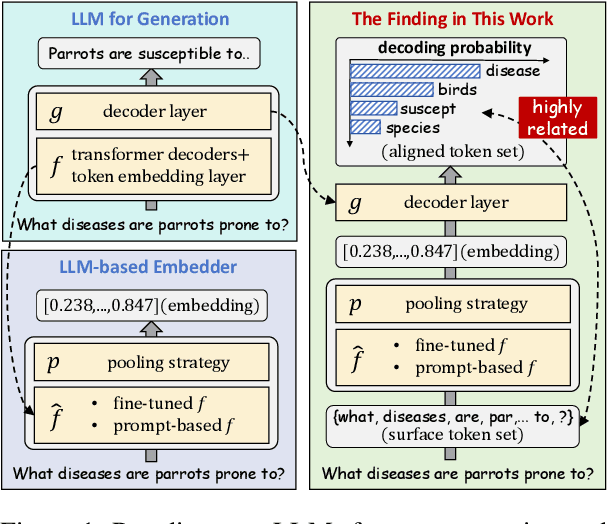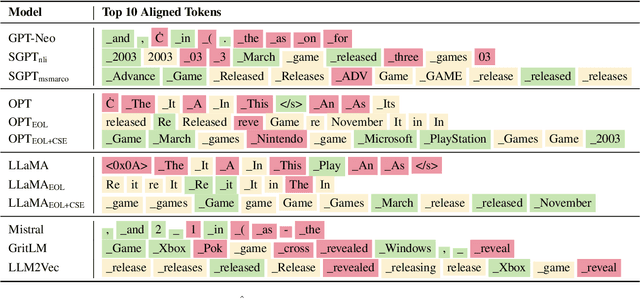Zhijie Nie
General Table Question Answering via Answer-Formula Joint Generation
Mar 16, 2025Abstract:Advanced table question answering (TableQA) methods prompt large language models (LLMs) to generate answer text, SQL query, Python code, or custom operations, which impressively improve the complex reasoning problems in the TableQA task. However, these methods lack the versatility to cope with specific question types or table structures. In contrast, the Spreadsheet Formula, the widely-used and well-defined operation language for tabular data, has not been thoroughly explored to solve TableQA. In this paper, we first attempt to use Formula as the logical form for solving complex reasoning on the tables with different structures. Specifically, we construct a large Formula-annotated TableQA dataset \texttt{FromulaQA} from existing datasets. In addition, we propose \texttt{TabAF}, a general table answering framework to solve multiple types of tasks over multiple types of tables simultaneously. Unlike existing methods, \texttt{TabAF} decodes answers and Formulas with a single LLM backbone, demonstrating great versatility and generalization. \texttt{TabAF} based on Llama3.1-70B achieves new state-of-the-art performance on the WikiTableQuestion, HiTab and TabFact.
A Graph-based Verification Framework for Fact-Checking
Mar 10, 2025Abstract:Fact-checking plays a crucial role in combating misinformation. Existing methods using large language models (LLMs) for claim decomposition face two key limitations: (1) insufficient decomposition, introducing unnecessary complexity to the verification process, and (2) ambiguity of mentions, leading to incorrect verification results. To address these challenges, we suggest introducing a claim graph consisting of triplets to address the insufficient decomposition problem and reduce mention ambiguity through graph structure. Based on this core idea, we propose a graph-based framework, GraphFC, for fact-checking. The framework features three key components: graph construction, which builds both claim and evidence graphs; graph-guided planning, which prioritizes the triplet verification order; and graph-guided checking, which verifies the triples one by one between claim and evidence graphs. Extensive experiments show that GraphFC enables fine-grained decomposition while resolving referential ambiguities through relational constraints, achieving state-of-the-art performance across three datasets.
Rethink the Evaluation Protocol of Model Merging on Classification Task
Dec 18, 2024



Abstract:Model merging combines multiple fine-tuned models into a single one via parameter fusion, achieving improvements across many tasks. However, in the classification task, we find a misalignment issue between merging outputs and the fine-tuned classifier, which limits its effectiveness. In this paper, we demonstrate the following observations: (1) The embedding quality of the merging outputs is already very high, and the primary reason for the differences in classification performance lies in the misalignment issue. (2) We propose FT-Classifier, a new protocol that fine-tunes an aligned classifier with few-shot samples to alleviate misalignment, enabling better evaluation of merging outputs and improved classification performance. (3) The misalignment is relatively straightforward and can be formulated as an orthogonal transformation. Experiments demonstrate the existence of misalignment and the effectiveness of our FT-Classifier evaluation protocol.
When Text Embedding Meets Large Language Model: A Comprehensive Survey
Dec 12, 2024



Abstract:Text embedding has become a foundational technology in natural language processing (NLP) during the deep learning era, driving advancements across a wide array of downstream tasks. While many natural language understanding challenges can now be modeled using generative paradigms and leverage the robust generative and comprehension capabilities of large language models (LLMs), numerous practical applications, such as semantic matching, clustering, and information retrieval, continue to rely on text embeddings for their efficiency and effectiveness. In this survey, we categorize the interplay between LLMs and text embeddings into three overarching themes: (1) LLM-augmented text embedding, enhancing traditional embedding methods with LLMs; (2) LLMs as text embedders, utilizing their innate capabilities for embedding generation; and (3) Text embedding understanding with LLMs, leveraging LLMs to analyze and interpret embeddings. By organizing these efforts based on interaction patterns rather than specific downstream applications, we offer a novel and systematic overview of contributions from various research and application domains in the era of LLMs. Furthermore, we highlight the unresolved challenges that persisted in the pre-LLM era with pre-trained language models (PLMs) and explore the emerging obstacles brought forth by LLMs. Building on this analysis, we outline prospective directions for the evolution of text embedding, addressing both theoretical and practical opportunities in the rapidly advancing landscape of NLP.
Improving General Text Embedding Model: Tackling Task Conflict and Data Imbalance through Model Merging
Oct 19, 2024



Abstract:Text embeddings are vital for tasks such as text retrieval and semantic textual similarity (STS). Recently, the advent of pretrained language models, along with unified benchmarks like the Massive Text Embedding Benchmark (MTEB), has facilitated the development of versatile general-purpose text embedding models. Advanced embedding models are typically developed using large-scale multi-task data and joint training across multiple tasks. However, our experimental analysis reveals two significant drawbacks of joint training: 1) Task Conflict: Gradients from different tasks interfere with each other, leading to negative transfer. 2) Data Imbalance: Disproportionate data distribution introduces biases that negatively impact performance across tasks. To overcome these challenges, we explore model merging-a technique that combines independently trained models to mitigate gradient conflicts and balance data distribution. We introduce a novel method, Self Positioning, which efficiently searches for optimal model combinations within the interpolation space of task vectors using stochastic gradient descent. Our experiments demonstrate that Self Positioning significantly enhances multi-task performance on the MTEB dataset, achieving an absolute improvement of 0.7 points. It outperforms traditional resampling methods while reducing computational costs. This work offers a robust approach to building generalized text embedding models with superior performance across diverse embedding-related tasks.
EasyRAG: Efficient Retrieval-Augmented Generation Framework for Automated Network Operations
Oct 15, 2024Abstract:This paper presents EasyRAG, a simple, lightweight, and efficient retrieval-augmented generation framework for automated network operations. Our framework has three advantages. The first is accurate question answering. We designed a straightforward RAG scheme based on (1) a specific data processing workflow (2) dual-route sparse retrieval for coarse ranking (3) LLM Reranker for reranking (4) LLM answer generation and optimization. This approach achieved first place in the GLM4 track in the preliminary round and second place in the GLM4 track in the semifinals. The second is simple deployment. Our method primarily consists of BM25 retrieval and BGE-reranker reranking, requiring no fine-tuning of any models, occupying minimal VRAM, easy to deploy, and highly scalable; we provide a flexible code library with various search and generation strategies, facilitating custom process implementation. The last one is efficient inference. We designed an efficient inference acceleration scheme for the entire coarse ranking, reranking, and generation process that significantly reduces the inference latency of RAG while maintaining a good level of accuracy; each acceleration scheme can be plug-and-play into any component of the RAG process, consistently enhancing the efficiency of the RAG system. Our code and data are released at \url{https://github.com/BUAADreamer/EasyRAG}.
Tool-Assisted Agent on SQL Inspection and Refinement in Real-World Scenarios
Aug 30, 2024Abstract:Recent Text-to-SQL methods leverage large language models (LLMs) by incorporating feedback from the database management system. While these methods effectively address execution errors in SQL queries, they struggle with database mismatches -- errors that do not trigger execution exceptions. Database mismatches include issues such as condition mismatches and stricter constraint mismatches, both of which are more prevalent in real-world scenarios. To address these challenges, we propose a tool-assisted agent framework for SQL inspection and refinement, equipping the LLM-based agent with two specialized tools: a retriever and a detector, designed to diagnose and correct SQL queries with database mismatches. These tools enhance the capability of LLMs to handle real-world queries more effectively. We also introduce Spider-Mismatch, a new dataset specifically constructed to reflect the condition mismatch problems encountered in real-world scenarios. Experimental results demonstrate that our method achieves the highest performance on the averaged results of the Spider and Spider-Realistic datasets in few-shot settings, and it significantly outperforms baseline methods on the more realistic dataset, Spider-Mismatch.
Improving the Consistency in Cross-Lingual Cross-Modal Retrieval with 1-to-K Contrastive Learning
Jun 26, 2024Abstract:Cross-lingual Cross-modal Retrieval (CCR) is an essential task in web search, which aims to break the barriers between modality and language simultaneously and achieves image-text retrieval in the multi-lingual scenario with a single model. In recent years, excellent progress has been made based on cross-lingual cross-modal pre-training; particularly, the methods based on contrastive learning on large-scale data have significantly improved retrieval tasks. However, these methods directly follow the existing pre-training methods in the cross-lingual or cross-modal domain, leading to two problems of inconsistency in CCR: The methods with cross-lingual style suffer from the intra-modal error propagation, resulting in inconsistent recall performance across languages in the whole dataset. The methods with cross-modal style suffer from the inter-modal optimization direction bias, resulting in inconsistent rank across languages within each instance, which cannot be reflected by Recall@K. To solve these problems, we propose a simple but effective 1-to-K contrastive learning method, which treats each language equally and eliminates error propagation and optimization bias. In addition, we propose a new evaluation metric, Mean Rank Variance (MRV), to reflect the rank inconsistency across languages within each instance. Extensive experiments on four CCR datasets show that our method improves both recall rates and MRV with smaller-scale pre-trained data, achieving the new state-of-art.
A Text is Worth Several Tokens: Text Embedding from LLMs Secretly Aligns Well with The Key Tokens
Jun 25, 2024



Abstract:Text embeddings from large language models (LLMs) have achieved excellent results in tasks such as information retrieval, semantic textual similarity, etc. In this work, we show an interesting finding: when feeding a text into the embedding LLMs, the obtained text embedding will be able to be aligned with the key tokens in the input text. We first fully analyze this phenomenon on eight embedding LLMs and show that this phenomenon is universal and is not affected by model architecture, training strategy, and embedding method. With a deeper analysis, we then find that the main change in embedding space between the embedding LLMs and their original generative LLMs is in the first principal component. By adjusting the first principal component, we can align text embedding with the key tokens. Finally, we give several examples to demonstrate the vast application potential of this finding: (1) we propose a simple and practical sparse retrieval method based on the aligned tokens, which can achieve 80\% of the dense retrieval effect of the same model while reducing the computation significantly; (2) we show that our findings provide a fresh perspective to help understand fuzzy concepts (e.g., semantic relatedness vs. semantic similarity) and emerging technologies (e.g., instruction-following embedding) in this field.
Improving Composed Image Retrieval via Contrastive Learning with Scaling Positives and Negatives
Apr 17, 2024Abstract:The Composed Image Retrieval (CIR) task aims to retrieve target images using a composed query consisting of a reference image and a modified text. Advanced methods often utilize contrastive learning as the optimization objective, which benefits from adequate positive and negative examples. However, the triplet for CIR incurs high manual annotation costs, resulting in limited positive examples. Furthermore, existing methods commonly use in-batch negative sampling, which reduces the negative number available for the model. To address the problem of lack of positives, we propose a data generation method by leveraging a multi-modal large language model to construct triplets for CIR. To introduce more negatives during fine-tuning, we design a two-stage fine-tuning framework for CIR, whose second stage introduces plenty of static representations of negatives to optimize the representation space rapidly. The above two improvements can be effectively stacked and designed to be plug-and-play, easily applied to existing CIR models without changing their original architectures. Extensive experiments and ablation analysis demonstrate that our method effectively scales positives and negatives and achieves state-of-the-art results on both FashionIQ and CIRR datasets. In addition, our methods also perform well in zero-shot composed image retrieval, providing a new CIR solution for the low-resources scenario.
 Add to Chrome
Add to Chrome Add to Firefox
Add to Firefox Add to Edge
Add to Edge